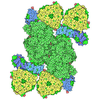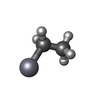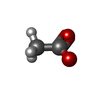+ Open data
Open data
- Basic information
Basic information
| Entry | Database: PDB / ID: 1cjx | ||||||
|---|---|---|---|---|---|---|---|
| Title | CRYSTAL STRUCTURE OF PSEUDOMONAS FLUORESCENS HPPD | ||||||
 Components Components | 4-HYDROXYPHENYLPYRUVATE DIOXYGENASE | ||||||
 Keywords Keywords | OXIDOREDUCTASE / Dioxygenase / Iron | ||||||
| Function / homology |  Function and homology information Function and homology information4-hydroxyphenylpyruvate dioxygenase / 4-hydroxyphenylpyruvate dioxygenase activity / L-tyrosine catabolic process / L-phenylalanine catabolic process / metal ion binding Similarity search - Function | ||||||
| Biological species |  Pseudomonas fluorescens (bacteria) Pseudomonas fluorescens (bacteria) | ||||||
| Method |  X-RAY DIFFRACTION / X-RAY DIFFRACTION /  SYNCHROTRON / SYNCHROTRON /  SIRAS / Resolution: 2.4 Å SIRAS / Resolution: 2.4 Å | ||||||
 Authors Authors | Serre, L. / Sailland, A. / Sy, D. / Boudec, P. / Rolland, A. / Pebay-Peroulla, E. / Cohen-Addad, C. | ||||||
 Citation Citation |  Journal: Structure Fold.Des. / Year: 1999 Journal: Structure Fold.Des. / Year: 1999Title: Crystal structure of Pseudomonas fluorescens 4-hydroxyphenylpyruvate dioxygenase: an enzyme involved in the tyrosine degradation pathway. Authors: Serre, L. / Sailland, A. / Sy, D. / Boudec, P. / Rolland, A. / Pebay-Peyroula, E. / Cohen-Addad, C. | ||||||
| History |
|
- Structure visualization
Structure visualization
| Structure viewer | Molecule:  Molmil Molmil Jmol/JSmol Jmol/JSmol |
|---|
- Downloads & links
Downloads & links
- Download
Download
| PDBx/mmCIF format |  1cjx.cif.gz 1cjx.cif.gz | 294.3 KB | Display |  PDBx/mmCIF format PDBx/mmCIF format |
|---|---|---|---|---|
| PDB format |  pdb1cjx.ent.gz pdb1cjx.ent.gz | 240.1 KB | Display |  PDB format PDB format |
| PDBx/mmJSON format |  1cjx.json.gz 1cjx.json.gz | Tree view |  PDBx/mmJSON format PDBx/mmJSON format | |
| Others |  Other downloads Other downloads |
-Validation report
| Summary document |  1cjx_validation.pdf.gz 1cjx_validation.pdf.gz | 412 KB | Display |  wwPDB validaton report wwPDB validaton report |
|---|---|---|---|---|
| Full document |  1cjx_full_validation.pdf.gz 1cjx_full_validation.pdf.gz | 437.5 KB | Display | |
| Data in XML |  1cjx_validation.xml.gz 1cjx_validation.xml.gz | 30.6 KB | Display | |
| Data in CIF |  1cjx_validation.cif.gz 1cjx_validation.cif.gz | 49.2 KB | Display | |
| Arichive directory |  https://data.pdbj.org/pub/pdb/validation_reports/cj/1cjx https://data.pdbj.org/pub/pdb/validation_reports/cj/1cjx ftp://data.pdbj.org/pub/pdb/validation_reports/cj/1cjx ftp://data.pdbj.org/pub/pdb/validation_reports/cj/1cjx | HTTPS FTP |
-Related structure data
| Similar structure data |
|---|
- Links
Links
- Assembly
Assembly
| Deposited unit | 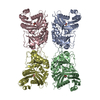
| ||||||||||||||||
|---|---|---|---|---|---|---|---|---|---|---|---|---|---|---|---|---|---|
| 1 |
| ||||||||||||||||
| Unit cell |
| ||||||||||||||||
| Noncrystallographic symmetry (NCS) | NCS oper:
|
- Components
Components
| #1: Protein | Mass: 40094.422 Da / Num. of mol.: 4 Source method: isolated from a genetically manipulated source Source: (gene. exp.)  Pseudomonas fluorescens (bacteria) / Cell line: A32 / Cell line (production host): A32 / Production host: Pseudomonas fluorescens (bacteria) / Cell line: A32 / Cell line (production host): A32 / Production host:  Pseudomonas fluorescens (bacteria) Pseudomonas fluorescens (bacteria)References: UniProt: P80064, 4-hydroxyphenylpyruvate dioxygenase #2: Chemical | ChemComp-FE2 / #3: Chemical | ChemComp-EMC / #4: Chemical | ChemComp-ACT / #5: Water | ChemComp-HOH / | |
|---|
-Experimental details
-Experiment
| Experiment | Method:  X-RAY DIFFRACTION / Number of used crystals: 1 X-RAY DIFFRACTION / Number of used crystals: 1 |
|---|
- Sample preparation
Sample preparation
| Crystal | Density Matthews: 2.83 Å3/Da / Density % sol: 57.2 % | |||||||||||||||||||||||||
|---|---|---|---|---|---|---|---|---|---|---|---|---|---|---|---|---|---|---|---|---|---|---|---|---|---|---|
| Crystal grow | pH: 5.6 Details: 18-25 % PEG 4000 0.2 M AMMONIUM ACETATE, 0.1 M CITRATE, PH 5.6 | |||||||||||||||||||||||||
| Crystal grow | *PLUS Method: vapor diffusion, hanging drop | |||||||||||||||||||||||||
| Components of the solutions | *PLUS
|
-Data collection
| Diffraction | Mean temperature: 100 K |
|---|---|
| Diffraction source | Source:  SYNCHROTRON / Site: SYNCHROTRON / Site:  ESRF ESRF  / Beamline: BM02 / Wavelength: 0.91 / Beamline: BM02 / Wavelength: 0.91 |
| Detector | Detector: CCD / Date: Jun 1, 1996 |
| Radiation | Protocol: SINGLE WAVELENGTH / Monochromatic (M) / Laue (L): M / Scattering type: x-ray |
| Radiation wavelength | Wavelength: 0.91 Å / Relative weight: 1 |
| Reflection | Resolution: 2.4→40 Å / Num. obs: 64393 / % possible obs: 93.2 % / Observed criterion σ(I): 1 / Redundancy: 4.4 % / Rsym value: 8 / Net I/σ(I): 41.67 |
| Reflection shell | Resolution: 2.4→3 Å / Redundancy: 3.1 % / Rsym value: 14.3 / % possible all: 86.7 |
| Reflection | *PLUS Num. measured all: 283368 / Rmerge(I) obs: 0.08 |
- Processing
Processing
| Software |
| ||||||||||||||||||||||||||||||||||||||||||||||||||||||||||||||||||||||||||||||||||||
|---|---|---|---|---|---|---|---|---|---|---|---|---|---|---|---|---|---|---|---|---|---|---|---|---|---|---|---|---|---|---|---|---|---|---|---|---|---|---|---|---|---|---|---|---|---|---|---|---|---|---|---|---|---|---|---|---|---|---|---|---|---|---|---|---|---|---|---|---|---|---|---|---|---|---|---|---|---|---|---|---|---|---|---|---|---|
| Refinement | Method to determine structure:  SIRAS / Resolution: 2.4→20 Å / SU B: 9.01 / SU ML: 0.2 / Cross valid method: THROUGHOUT / σ(F): 0 / ESU R: 0.51 / ESU R Free: 0.29 SIRAS / Resolution: 2.4→20 Å / SU B: 9.01 / SU ML: 0.2 / Cross valid method: THROUGHOUT / σ(F): 0 / ESU R: 0.51 / ESU R Free: 0.29
| ||||||||||||||||||||||||||||||||||||||||||||||||||||||||||||||||||||||||||||||||||||
| Displacement parameters | Biso mean: 31.18 Å2 | ||||||||||||||||||||||||||||||||||||||||||||||||||||||||||||||||||||||||||||||||||||
| Refinement step | Cycle: LAST / Resolution: 2.4→20 Å
| ||||||||||||||||||||||||||||||||||||||||||||||||||||||||||||||||||||||||||||||||||||
| Refine LS restraints |
| ||||||||||||||||||||||||||||||||||||||||||||||||||||||||||||||||||||||||||||||||||||
| Software | *PLUS Name: REFMAC / Classification: refinement | ||||||||||||||||||||||||||||||||||||||||||||||||||||||||||||||||||||||||||||||||||||
| Refinement | *PLUS σ(F): 0 / % reflection Rfree: 5 % / Rfactor obs: 0.219 | ||||||||||||||||||||||||||||||||||||||||||||||||||||||||||||||||||||||||||||||||||||
| Solvent computation | *PLUS | ||||||||||||||||||||||||||||||||||||||||||||||||||||||||||||||||||||||||||||||||||||
| Displacement parameters | *PLUS |
 Movie
Movie Controller
Controller



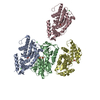
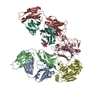
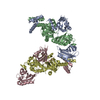


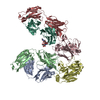
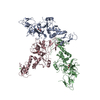

 PDBj
PDBj



